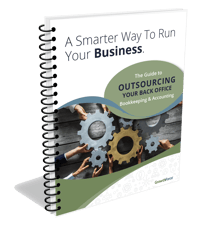9 min read

Calculators, number 2 pencils, green lamps, ledger books, and giant filing cabinets: what do these things have in common? They are relics from the past way businesses used to do accounting.
Nowadays, there’s a more modern way of doing things, and for good reasons. The fact is, if your business still uses manual accounting processes, doing back-office procedures without automation, then it's costing you money — and let's be real: every business owner can find a better way to spend the money they're currently throwing away on outdated bookkeeping and accounting processes.
So why are some businesses still stuck in the past when it comes to their financial management? Two reasons– 1. Because “that’s the way you’ve always done it” or 2. Because the person who handles your bookkeeping doesn't know how to properly transition to automation.
We’ll dig into what it’s actually costing your business, but the biggest takeaway is that it’s important to fix this sooner than later.
Why Are Manual Business Procedures So Expensive?
Several factors contribute to the overwhelming cost of manual accounting procedures. These are some of the biggest:
1. Employee’s Time
You’ve heard it before- “time is money”. Unfortunately, this old adage especially rings true in the business world.
It's not the number 2 pencils that cost your business, but rather the number-2-pencil-pushers. Employee time is an enormous expense; employees are your most expensive (and your most valuable) asset.
Don’t believe us? Let’s look at what just an extra 15 minutes will do on your bottom line.
In a standard 40-hour work week, 15 minutes of non-productive, non-billable time is equal to .25 hours a day, 1.25 hours a week, or 65 total hours a year. For a $3 million business, an increase of productivity of that magnitude translates to more than $93,000 annually.
Ensuring that your employees spend their time on high-value tasks, rather than back office procedures that could be automated is essential in ensuring you're getting the most value and profitability out of your people.
2. Fraud Risk
It's an unfortunate reality to face, but small businesses stand to lose the most and face the highest risk of internal fraud and theft by employees. In fact, companies with fewer than 100 employees incur a median loss of $200,000 due to fraud – nearly twice as much as those incurred by businesses with more than 100 employees.
You may be thinking, “Nah, I trust my bookkeeper!” But it's not about how you feel, it’s about that way of thinking that’s the problem.
Manual back-office processes have security holes that expose your company to internal and external fraud risks. These risks aren't something you can ignore, and hope they never happen to you.
With limited personnel and limited time for business owners to scour the books for errors, manual accounting processes leave small and medium-sized businesses exceptionally vulnerable to these types of losses.
3. General Back Office Blunders
Manual bookkeeping and accounting processes naturally lead to room for errors, mistakes, and other blunders like double-entries, missed entries, poorly timed payments, and undesirable invoicing procedures. All of this results in lost income, incurring fees and penalties, and the distribution of inaccurate and late financial reports.
This leads to a bigger issue- you can’t make strategic decisions with unreliable data.
When your back office is riddled with bookkeeping errors, you can never truly trust your business's numbers. You won't know your true costs, you won't be able to optimize your pricing or streamline your operations, and you won't actually know whether or not you've been profitable (or how profitable you've been).
4. Poorly Formed and Executed Business Strategies
A manual back office will force you to struggle, not leading your business the way you should be. With a poorly functioning back office, business leaders find themselves reacting to challenges, rather than making data-driven decisions to plan for or avoid pitfalls altogether.
Without accurate data and a transparent view of your business's financial health, there's no way for a business leader to strategize, make data-driven decisions, choose appropriate business goals, set benchmarks for meeting those goals, measure progress, or rally an entire team around a common vision.
An automated back office provides timely and accurate financial reporting complete with all the KPIs that are most important to establishing, tracking, and managing your business strategy. A robust back office makes it easy to define, implement, and execute an operating framework for your business.
What Business Procedures Can Be Automated and Improved?
The easier question to answer is what back-office procedures can't be automated?
So many automated solutions for bookkeeping and accounting exist today that you can automate just about anything, transforming your business operations from completely manual into entirely automated, streamlined, and even decentralized processes (or somewhere in between).
You can decide which automated processes will function best for you and your vision for the future of your company.
Depending on your business structure and operations, the following back office processes are some of the most cost-effective and/or profitable to automate.
Time Tracking + HR Procedures
While you can't (and probably shouldn't) automate your daily round of "good mornings," monthly pizza parties, or the praise you offer for good work, you can streamline other back office processes related to your employees and human resources department.
This includes time tracking and measuring the people-related metrics that will help you perfect your human capital management strategy. For example: There are integrations that you can use to automate time tracking and benefits accrual/usage across your company. One of our favorites is TSheets. This is particularly vital for services businesses that are making money on people’s time.
Automating back-office processes related to HR will free up the minds in your human resource department to work on more goal-oriented tasks. In turn, this will help you maximize profitability in your people, increase employee retention, perfect your hiring process, accurately track and allocate time, streamline your operations, and more.
Invoicing, Bill Payment, and Expense Tracking
While sending out invoices and remitting payments might seem simple enough, you can make the most out of your accounts payable and accounts receivable with properly streamlined and automated processes.
You can automate the process of paying and approving bills, in addition to streamlining your invoicing and payment procedures, while expense trackers keep all your costs neatly recorded and organized for management, compliance, or tax purposes.
This type of automation ensures you're taking full advantage of early payment discounts, collecting payments on-time, and tracking all of your expenses for accurate KPI reporting.
Document Management
Whether you're wrangling receipts, updating contracts, or scouring client files for missing documents or other exceptions, you and your employees are spending time on paperwork that could be better spent elsewhere.
Thanks to the rise of technology, a lot of small businesses have been capitalizing on software integrations- the process of bringing various software systems together to make one unified system (basically- Different applications “talk” and “work” together to complete a goal). These advanced integrations allow for more data in your accounting system, more quickly, eliminating errors, and at a lower cost than with manual processes.
Depending on your unique needs, there are a variety of fully integrated, automated tools that will save you time and stress when it comes to managing all the paperwork on which your business relies to operate smoothly and stay in compliance with tax laws and other rules and regulations.
💡TIP: Before you opt into a new automated tool, check to see its other software integrations. This will save you major headaches in the future.
Forecasting
Perhaps the most important aspect of an automated back office is its ability to simplify the process of cash flow forecasting in your business.
With all your financial data accurately and automatically recorded, a business owner will have continual access to a complete set of accurate, up-to-date financial reports.
This not only affords you an accurate diagnosis of your company's current financial health, but it also allows you to accurately forecast your company's future financial picture based on your past performance. This information is vital in making data-driven decisions.
These valuable financial insights lend business owners the ability to make data-driven decisions to lead their businesses through upcoming challenges, to maximize profitability, and achieve their business goals.
Inventory Processes
Do you have employees who are responsible for manually counting your inventory? If so, you're missing out on time-saving tactics that will not only cut inventory-related costs, but will also enhance the way you do business. Manual inventory management practices and lagging warehouse procedures can lead to inaccurate financial data.
With a better system for inventory, you'll be able to track your rate of inventory turnover, days to sell, and other useful inventory-related metrics. Automated inventory processes help save your staff time on actually doing inventory and also help avoid inventory-related interruptions to workflow while enabling you to improve your cash flow.
In addition, having an efficient, automated inventory management procedure will help you make more informed pricing decisions because you have a clear track record of your selling trends.
How to Automate Your Back Office the Easy & Most Efficient Way
While it may seem that automated procedures exist to replace employees, that could not be further from the truth. It’s the combination of the right team and technology that will generate the most results.
Today, professional outsourcing services are available to help small and medium-sized businesses flourish with affordable, automated, outsourced back offices.
Through outsourcing, small to medium sized businesses especially can benefit from the power of having a fully functional back office and access to highly experienced accounting professionals.
Outsourced accounting experts are able to optimize your accounting system with the best tools and technology available for your industry, show you how to use it, and help you interpret your business's financial reports.
As a result, you'll shed the risks and high costs of operating with manual bookkeeping and accounting procedures. You’ll learn how to leverage your back office as a platform for growth and get insights from your newly automated bookkeeping and accounting processes.

.png?width=563&height=144&name=New%20GF%20Logo%20(37).png)


